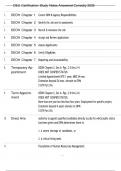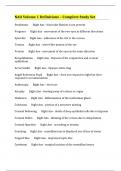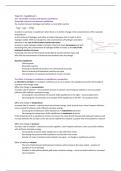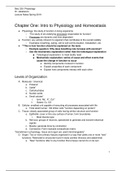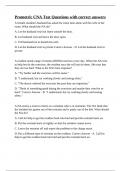Summary Strategy an International Perspective
Chapter 1 Introduction
There can be two approaches distinguished about learning: tools-driven – all major theories would
first be understood separately, to be compared or combined later when using them in practice. And
problem-driven – key strategy issues are first identified and then each is looked at from the
perspective of the most appropriate theories (book is based on this approach).
Two important inputs for strategy are the cognitive processes of individual strategist (strategizing)
and purpose as the impetus for strategy activities (missioning and visioning). It is widely assumed
that strategist are rational actors who identify, determine, evaluate, choose, translate and carry out,
based on rigorous logic and extensive knowledge of all important factors. This believe has been
challenged. In their opinion, strategizing is about perceiving strength and weaknesses, envisioning
opportunities and threats, and creating the future. In reality there is also an extensive disagreement
about what the current purpose of organizations are.
The most fundamental distinction is between strategy content, strategy process and strategy
context. Strategy content, process, and context are not different parts of strategy, but are
distinguishable dimensions. Each strategic problem situation is by its nature three-dimensional, and
only the understanding of all three dimensions will give the strategist real depth of comprehension.
The three dimensions interact.
Strategy content – the combined decisions and choices that lead a company into the future.
Stated in terms of a question, strategy content is concerned with the what of strategy.
Strategy process – the manner in which strategies come about. Stated in terms of a number
of questions, strategy process is concerned with how, who and when of strategy.
Strategy context – the set of circumstances under which both the strategy content and
strategy process are determined. Stated in terms of a question, it is concerned with the
where of strategy.
Most strategy research by, its very nature, is more atomistic than
holistic, focussing on just a few variables at once. Most tend to
favour just one, or at most two, strategy dimensions, while keeping
the other one(s) in mind.
Within strategy content there are three fundamental sets of issues
around which most conflicts are generally centre. These topics can
be clarified by distinguishing the level of strategy at which each is
most relevant. The lowest level of aggregation is one person or
task, while the highest level encompasses all people or activities
within an organization. The most common distinction between
levels of aggregation made in strategic management literature is
between functional, business and corporate levels.
Strategy issues at functional level refer to questions
regarding specific functional aspects of a company.
Functional department
, Strategy at business level requires the integration of functional levels strategies for a distinct
set of products and/or services intended for a specific groups of customers. Operating unit
Strategy at corporate levels is required which aligns the various business strategies and
different business units. Corporation/group
Network level is a multi-company level, and is higher than individual organizations.
Alliance/partnership.
Strategy process is usually split between strategy analysis stage, strategy formulation stage and
strategy implementation stage. In the analysis stage, strategist identify the opportunities and threats
in the environment, as well as the strengths and weaknesses of the organisation. In the formulation
stage strategist determine which strategic options are available to them, evaluate each and choose
one. In the implementation stage, the selected strategic option is translated into a number of
concrete activities which are carried out. The division of strategy process in a number of sequential
phases has drawn heavy criticism form authors who believe that in realities, no such identifiable
stage exist. They believe that strategies are usually formed incrementally, as organisations think and
act in small iterative steps, letting strategies emerge as they go along.
Another major assumption of the traditional view, the strategy is made for the entire organization
and everything can be radically changes all at once, has also been challenged. They have point out
that it is unrealistic to suppose that a company can be boldly redesigned. In practice, different
aspects of an organisation will be under different pressures, on different timetables and have
different abilities to change, leading to a different approach to change.
With regards to the strategy context there are also different believes and assumptions. There are
different aspects of strategy context: international, industry, organizational. But all the parts will be
discussed in further chapters.
Every real-life strategic problem is complex. At the heart of every set of strategic issues, a
fundamental tension between apparent opposites can be identified. The challenge of strategist is to
wrestle with these tricky strategy tensions. All strategy theories make assumptions, explicitly or
implicitly, about the nature of these tensions and devise ways to deal with them. There are different
perspectives on dealing with this tension. For each chapter there are two perspectives which
represent the two extreme ways of dealing with a strategy tension.
With strategy perspectives emphasizing the importance of one
side of a strategy tension over the other, how should strategist
deal with these opposites? In general, there are two
fundamentally different kind of problems, ‘either/or problems’
and ‘both/and problems’, each should be handled in a different
way. Either/or problems are for example: puzzles (a challenging
problem with an optimal solution) and dilemma’s (a vexing
problem with two possible solutions). Both/and problems are for
example: trade-offs (a problem in which there are many possible
solutions) and paradoxes (a situation in which two seemingly
contradictory factors appear to be true at the same time.
The strategy tensions will be presented as strategy paradoxes. These two opposite positions are in
fact the thesis and antitheses of the debate, challenging the reader to search for an appropriate
option to manage the two tensions. This form of debate is called ‘dialectical enquiring’ – by using two
,opposite points of view, the problem-solver attempts to arrive at a better understanding of the issue
and a ‘higher level resolution’ that integrates both elements of antithesis and thesis. This approach
has a number of advantages
Range of ideas – the book-end-function of presenting two opposite perspectives – they
‘frame’ the full set of views that exist in the topic
Points of contention – contrast function of presenting two opposite perspectives – they bring
the key points of contention into sharper focus.
Stimulus for creativity – generative function of presenting the two opposite perspectives –
they stimulate the reader to generate innovative ways of transcending the strategic paradox.
When faced with strategy paradoxes strategizing manners have a range of options for dealing with
the opposite elements of an issue – some of them desirable and others not. Not every solution will
do – a common misunderstanding when there is no single solution – and there is no fixed number of
options.
Navigating – focus on contrary demand at a time. The paradox is managed over time by a
series of contrary initiatives which leads to a development path comparable with a tacking
sailing boat. Also known as temporal separation or punctual equilibrium.
Parallel processing – separate the contrary demands in different internal (departments or
business units) or external (alliance partners) organizational unites. Often, the differentiated
demands are then integrated at different – usually higher – organizational level. Also known
as spatial separation.
Balancing – to manage opposite demands by trading off elements of opposing demands and
blending the most appropriate balance. The strategist is not searching for a (static) synthesis,
but instead chooses constituting elements circumstances (dynamics). Also known as Yin Yang
Balancing; blending; trade-off; dilemma’s and accepting contradictions.
Juxtaposing – to simultaneously manage opposite demands on a permanent basis. The
conflict between the two opposites is accepts, and the strategist will accommodate both
factors at the same time. It requires dynamic capabilities to manage the paradox on a daily or
project basis. Also knows as managing opposites simultaneously.
Resolving – arrive at a higher level equilibrium, by developing a new synthesis between
competing demands or by exploiting the tensions. Developing a novel synthesis creates a
new balance between contrary elements that will sustain for some time but will eventually
be replaced by a new one. Also known as synthesis; resolving the paradox; beyond trade-off
and best-of-both.
Embracing – to embrace and actively use the tension as a source of creativity and
opportunity. The conflict between two opposites is not only accepted but actually exploited
to benefit from the innovative power of tensions. Also known as dialect, combining and
exploit the tension.
As organisations are complex and dynamic systems in changing environments, the attractiveness of
available options may depend on the specific context (contingencies) and timing.
Developing an international perspective requires strategist to guard against the indiscriminate export
of domestically generated strategy theories across international boarders. For international strategist
it is important to question whether theories ‘travel’ as well as the companies they describe.
Chapter 2 Strategizing
, Generally, knowing what goes on in the minds of managers during strategy processes is essential for
understanding their choices and behaviours. Yet, for each reader personally, the topic of strategizing
is also of key importance. It triggers each person to explore their own thought process and critically
reflect on their own strategy preferences. What goes on in the mind of the strategist reduced to the
bare essentials it can be staid that they are engaged in the process of dealing with strategic problems
(in a neutral sense of challenging situations that need to be
resolved). A strategic problem is a set of circumstances
requiring a reconsideration of the current course of action,
either to profit from observed opportunities or to respond
to perceived threats. To deal with them, managers must go
to a strategic reasoning process, searching for ways to
define and solve the challenges.
We are often surprised by the power of the human mind,
but equally often stunned by its limitations. The human
ability is referred to as ‘cognition’, so they need to engage is
cognitive actions. These cognitive actions (or strategic thinking activities) need to be structured into
a strategic reasoning process. hence the first step it so examine various cognitive activities making up
a strategic reasoning process. To be able to perform these activities, people need to command
certain mental faculties. The brain consist of cognitive activities, cognitive maps and cognitive
abilities.
Cognitive activities mental tasks intended to increase knowledge. A general distinction can be
made between cognitive activities directed towards defining a strategic problem, and cognitive
activities directed as solving a strategic problem. Each of these major categories can be further split
into four:
Identifying; before a strategic can benefit from opportunities or counter threats, they must
be aware of these challenges and acknowledge their importance. Also referred to as
recognizing, sense-making or sensing.
Require extensive external and internal
scanning, thorough sifting of incoming
information and the selection of priority
issues.
Diagnosing; to grapple with a problem, you
must try to understand the structure of the
problem and its underlying causes. Also
referred to as analysing, reflecting or shaping.
Diagnosed by getting more detailed data, and
by further analysing and refining this
information.
Conceiving; to deal with a strategic problem, you must come up with a potential solution. If
more than one solution is available, you must select the most promising one. Also referred to
as formulating, imagining or seizing.
Realizing; a strategic problem is only really solved once concrete actions are undertaken that
achieve results. You must therefore carry out problem-solving activities and evaluate
whether the consequences are positive. Also referred to as implementing, acting or
reconfiguring. Strategist would need to ensure execution of proposed solution by consciously
planning and controlling implementation activities.
Chapter 1 Introduction
There can be two approaches distinguished about learning: tools-driven – all major theories would
first be understood separately, to be compared or combined later when using them in practice. And
problem-driven – key strategy issues are first identified and then each is looked at from the
perspective of the most appropriate theories (book is based on this approach).
Two important inputs for strategy are the cognitive processes of individual strategist (strategizing)
and purpose as the impetus for strategy activities (missioning and visioning). It is widely assumed
that strategist are rational actors who identify, determine, evaluate, choose, translate and carry out,
based on rigorous logic and extensive knowledge of all important factors. This believe has been
challenged. In their opinion, strategizing is about perceiving strength and weaknesses, envisioning
opportunities and threats, and creating the future. In reality there is also an extensive disagreement
about what the current purpose of organizations are.
The most fundamental distinction is between strategy content, strategy process and strategy
context. Strategy content, process, and context are not different parts of strategy, but are
distinguishable dimensions. Each strategic problem situation is by its nature three-dimensional, and
only the understanding of all three dimensions will give the strategist real depth of comprehension.
The three dimensions interact.
Strategy content – the combined decisions and choices that lead a company into the future.
Stated in terms of a question, strategy content is concerned with the what of strategy.
Strategy process – the manner in which strategies come about. Stated in terms of a number
of questions, strategy process is concerned with how, who and when of strategy.
Strategy context – the set of circumstances under which both the strategy content and
strategy process are determined. Stated in terms of a question, it is concerned with the
where of strategy.
Most strategy research by, its very nature, is more atomistic than
holistic, focussing on just a few variables at once. Most tend to
favour just one, or at most two, strategy dimensions, while keeping
the other one(s) in mind.
Within strategy content there are three fundamental sets of issues
around which most conflicts are generally centre. These topics can
be clarified by distinguishing the level of strategy at which each is
most relevant. The lowest level of aggregation is one person or
task, while the highest level encompasses all people or activities
within an organization. The most common distinction between
levels of aggregation made in strategic management literature is
between functional, business and corporate levels.
Strategy issues at functional level refer to questions
regarding specific functional aspects of a company.
Functional department
, Strategy at business level requires the integration of functional levels strategies for a distinct
set of products and/or services intended for a specific groups of customers. Operating unit
Strategy at corporate levels is required which aligns the various business strategies and
different business units. Corporation/group
Network level is a multi-company level, and is higher than individual organizations.
Alliance/partnership.
Strategy process is usually split between strategy analysis stage, strategy formulation stage and
strategy implementation stage. In the analysis stage, strategist identify the opportunities and threats
in the environment, as well as the strengths and weaknesses of the organisation. In the formulation
stage strategist determine which strategic options are available to them, evaluate each and choose
one. In the implementation stage, the selected strategic option is translated into a number of
concrete activities which are carried out. The division of strategy process in a number of sequential
phases has drawn heavy criticism form authors who believe that in realities, no such identifiable
stage exist. They believe that strategies are usually formed incrementally, as organisations think and
act in small iterative steps, letting strategies emerge as they go along.
Another major assumption of the traditional view, the strategy is made for the entire organization
and everything can be radically changes all at once, has also been challenged. They have point out
that it is unrealistic to suppose that a company can be boldly redesigned. In practice, different
aspects of an organisation will be under different pressures, on different timetables and have
different abilities to change, leading to a different approach to change.
With regards to the strategy context there are also different believes and assumptions. There are
different aspects of strategy context: international, industry, organizational. But all the parts will be
discussed in further chapters.
Every real-life strategic problem is complex. At the heart of every set of strategic issues, a
fundamental tension between apparent opposites can be identified. The challenge of strategist is to
wrestle with these tricky strategy tensions. All strategy theories make assumptions, explicitly or
implicitly, about the nature of these tensions and devise ways to deal with them. There are different
perspectives on dealing with this tension. For each chapter there are two perspectives which
represent the two extreme ways of dealing with a strategy tension.
With strategy perspectives emphasizing the importance of one
side of a strategy tension over the other, how should strategist
deal with these opposites? In general, there are two
fundamentally different kind of problems, ‘either/or problems’
and ‘both/and problems’, each should be handled in a different
way. Either/or problems are for example: puzzles (a challenging
problem with an optimal solution) and dilemma’s (a vexing
problem with two possible solutions). Both/and problems are for
example: trade-offs (a problem in which there are many possible
solutions) and paradoxes (a situation in which two seemingly
contradictory factors appear to be true at the same time.
The strategy tensions will be presented as strategy paradoxes. These two opposite positions are in
fact the thesis and antitheses of the debate, challenging the reader to search for an appropriate
option to manage the two tensions. This form of debate is called ‘dialectical enquiring’ – by using two
,opposite points of view, the problem-solver attempts to arrive at a better understanding of the issue
and a ‘higher level resolution’ that integrates both elements of antithesis and thesis. This approach
has a number of advantages
Range of ideas – the book-end-function of presenting two opposite perspectives – they
‘frame’ the full set of views that exist in the topic
Points of contention – contrast function of presenting two opposite perspectives – they bring
the key points of contention into sharper focus.
Stimulus for creativity – generative function of presenting the two opposite perspectives –
they stimulate the reader to generate innovative ways of transcending the strategic paradox.
When faced with strategy paradoxes strategizing manners have a range of options for dealing with
the opposite elements of an issue – some of them desirable and others not. Not every solution will
do – a common misunderstanding when there is no single solution – and there is no fixed number of
options.
Navigating – focus on contrary demand at a time. The paradox is managed over time by a
series of contrary initiatives which leads to a development path comparable with a tacking
sailing boat. Also known as temporal separation or punctual equilibrium.
Parallel processing – separate the contrary demands in different internal (departments or
business units) or external (alliance partners) organizational unites. Often, the differentiated
demands are then integrated at different – usually higher – organizational level. Also known
as spatial separation.
Balancing – to manage opposite demands by trading off elements of opposing demands and
blending the most appropriate balance. The strategist is not searching for a (static) synthesis,
but instead chooses constituting elements circumstances (dynamics). Also known as Yin Yang
Balancing; blending; trade-off; dilemma’s and accepting contradictions.
Juxtaposing – to simultaneously manage opposite demands on a permanent basis. The
conflict between the two opposites is accepts, and the strategist will accommodate both
factors at the same time. It requires dynamic capabilities to manage the paradox on a daily or
project basis. Also knows as managing opposites simultaneously.
Resolving – arrive at a higher level equilibrium, by developing a new synthesis between
competing demands or by exploiting the tensions. Developing a novel synthesis creates a
new balance between contrary elements that will sustain for some time but will eventually
be replaced by a new one. Also known as synthesis; resolving the paradox; beyond trade-off
and best-of-both.
Embracing – to embrace and actively use the tension as a source of creativity and
opportunity. The conflict between two opposites is not only accepted but actually exploited
to benefit from the innovative power of tensions. Also known as dialect, combining and
exploit the tension.
As organisations are complex and dynamic systems in changing environments, the attractiveness of
available options may depend on the specific context (contingencies) and timing.
Developing an international perspective requires strategist to guard against the indiscriminate export
of domestically generated strategy theories across international boarders. For international strategist
it is important to question whether theories ‘travel’ as well as the companies they describe.
Chapter 2 Strategizing
, Generally, knowing what goes on in the minds of managers during strategy processes is essential for
understanding their choices and behaviours. Yet, for each reader personally, the topic of strategizing
is also of key importance. It triggers each person to explore their own thought process and critically
reflect on their own strategy preferences. What goes on in the mind of the strategist reduced to the
bare essentials it can be staid that they are engaged in the process of dealing with strategic problems
(in a neutral sense of challenging situations that need to be
resolved). A strategic problem is a set of circumstances
requiring a reconsideration of the current course of action,
either to profit from observed opportunities or to respond
to perceived threats. To deal with them, managers must go
to a strategic reasoning process, searching for ways to
define and solve the challenges.
We are often surprised by the power of the human mind,
but equally often stunned by its limitations. The human
ability is referred to as ‘cognition’, so they need to engage is
cognitive actions. These cognitive actions (or strategic thinking activities) need to be structured into
a strategic reasoning process. hence the first step it so examine various cognitive activities making up
a strategic reasoning process. To be able to perform these activities, people need to command
certain mental faculties. The brain consist of cognitive activities, cognitive maps and cognitive
abilities.
Cognitive activities mental tasks intended to increase knowledge. A general distinction can be
made between cognitive activities directed towards defining a strategic problem, and cognitive
activities directed as solving a strategic problem. Each of these major categories can be further split
into four:
Identifying; before a strategic can benefit from opportunities or counter threats, they must
be aware of these challenges and acknowledge their importance. Also referred to as
recognizing, sense-making or sensing.
Require extensive external and internal
scanning, thorough sifting of incoming
information and the selection of priority
issues.
Diagnosing; to grapple with a problem, you
must try to understand the structure of the
problem and its underlying causes. Also
referred to as analysing, reflecting or shaping.
Diagnosed by getting more detailed data, and
by further analysing and refining this
information.
Conceiving; to deal with a strategic problem, you must come up with a potential solution. If
more than one solution is available, you must select the most promising one. Also referred to
as formulating, imagining or seizing.
Realizing; a strategic problem is only really solved once concrete actions are undertaken that
achieve results. You must therefore carry out problem-solving activities and evaluate
whether the consequences are positive. Also referred to as implementing, acting or
reconfiguring. Strategist would need to ensure execution of proposed solution by consciously
planning and controlling implementation activities.




